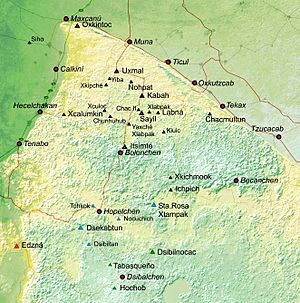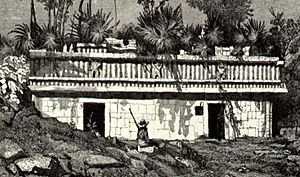Puuc facts for kids
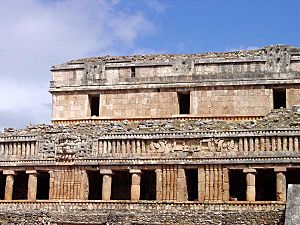
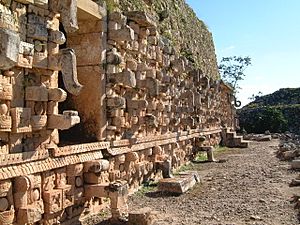
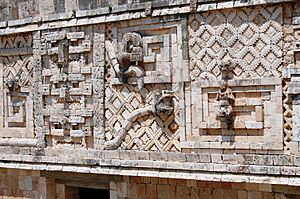
Puuc is a name that refers to two things. It can be a region in the Mexican state of Yucatán. It can also be a special Maya building style found in that area. The word puuc comes from a Maya word meaning "hill".
Since the Yucatán area is mostly flat, this word was used for the large range of hills in the southern part of the state. That's why people talk about the Puuc region or Puuc hills. These hills also stretch into northern Campeche and western Quintana Roo.
The term Puuc also describes the unique architectural style of ancient Maya sites in the Puuc hills. This is called Puuc architecture. This building style started late in the Late Classic period. But it became most popular during the Terminal Classic period.
Contents
What is Puuc Architecture Like?
During its most popular time, Puuc architecture was very impressive. Buildings, like those at the ancient Maya city of Uxmal, were decorated with carefully cut stones. These stones were like a thin layer (a veneer) placed over a concrete core.
Key Features of Puuc Buildings
The lower part of the buildings' fronts (façades) were usually plain. They had flat surfaces of rectangular blocks with doorways. But the upper part of the façade was very fancy. It had detailed stone mosaics. These mosaics often showed repeating geometric shapes. They also had more complex sculptures of figures. You can often see masks with long noses on many Puuc buildings. These masks are usually thought to represent Chaac, the Maya rain god.
How Puuc Builders Improved Architecture
Beyond the beautiful decorations, the use of a concrete core was a big step forward in building. Earlier Maya builders used large stones stacked with lime and mud for support. The concrete core with a stone veneer allowed for slightly bigger and more stable rooms inside. Many corbelled vaults (a type of arch) built in the Puuc style are still standing today. This is true even when most of their outer stone layers have fallen off.
Famous Puuc Sites to Explore
The most famous Maya site with the Puuc architectural style is Uxmal. Other important Puuc-style sites in the region include Labna, Kabah, Sayil, and Xlapak. You can also see this style at Kiuic, Bolonchen, Chunhuhub, Xculoc, and many smaller ruins.
The change from older Classic Period building styles to the Puuc core-veneer method is clear at the site of Oxkintok. To the south, you can find the style in Edzná. To the east, it appears at Chichen Itza, which is outside the main Puuc Hills region.
An explorer named Teobert Maler studied this area a lot. He noted that the area around the site of Dolores has many ruins. A recent project called Chunhuaymil gathered information on Puuc architecture. This project looked at 19 archaeological sites in a 100 square kilometer area.
Protecting the Puuc Region: A Special Reserve
The Puuc Biocultural State Reserve is also known as the Kaxil Kiuic reserve. It was created in 2011. This reserve covers a large area of about 1,358.93 square kilometers.
Why the Reserve is Important
The reserve was made to protect two main things:
- The important archaeological sites in the region.
- The many different kinds of plants and animals (biodiversity) that live there.
Animals and Plants of the Puuc Reserve
The reserve is home to many different species. It has 247 types of birds, 63 types of mammals, 52 types of reptiles, and 14 types of amphibians. Five kinds of large wild cats, including jaguars, also live in this special reserve.
See also
 In Spanish: Puuc para niños
In Spanish: Puuc para niños


